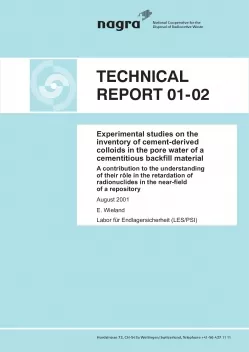
Technical Report NTB 01-02
Experimental studies on the inventory of cement-derived colloids in the pore water of a cementitious backfill material
The potential rôle of near-field colloids for the colloid-facilitated migration of radionuclides has stimulated investigations concerning the generation and presence of colloids in the near-field of a repository for low- and intermediate level waste (L/ILW). The highly gas permeable mortar (Nagra designation: mortar M1) is currently favoured as backfill material for the engineered barrier of the planned Swiss L/ILW repository. The cementitious backfill is considered to be a chemical environment with some potential for colloid generation.
In a series of batch-style laboratory experiments the physico-chemical processes controlling the inventory of colloids in cement pore water of the backfill were assessed for chemical conditions prevailing in the initial stage of the cement degradation. In these experiments, backfill mortar M1 or quartz, respectively, which may be used as aggregate material for the backfill, were immersed in artificial cement pore water (a NaOH/KOH rich cement fluid). Colloid concentrations in the cement pore water were recorded as a function of time for different experimental settings. The results indicate that a colloid-colloid interaction process (coagulation) controlled the colloid inventory. The mass concentration of dispersed colloids was found to be typically lower than 0.02 ppm in undisturbed batch systems. An upper-bound value was estimated to be 0.1 ppm taking into account uncertainties on the measurements.
To assess the potential for colloid generation in a dynamic system, colloid concentrations were determined in the pore water of a column filled with backfill mortar. The chemical conditions established in the mortar column corresponded to conditions observed in the second stage of the cement degradation (a Ca(OH)2-controlled cement system). In this dynamic system, the upper-bound value for the colloid mass concentration was estimated to be 0.1 ppm.
Implications for radionuclide mobility were deduced taking into account the experimental results of the study. Predictions of the colloidal effect on radionuclide mobility were based on the assumption that colloids dispersed in the pore water of the backfill material may reduce radionuclide sorption (Rd values) on cement. This effect was described in terms of a sorption reduction factor. The distribution ratios (Rc) of radionuclides between the cement pore water and the colloidal phase as well as the colloid mass concentration (mc) are the two important colloidal parameters affecting sorption reduction. No significant sorption reduction is expected for weakly and moderately sorbing radionuclides (Rd ≤ 1 m3 kg-1) up to a colloid concentration of 1 ppm. Moreover, no significant sorption reduction is anticipated for strongly sorbing radionuclides (Rd > 1 m3 kg-1) below colloid concentrations of 0.1 ppm. This value is considered to be representative for the backfill material. At higher colloid concentrations, however, sorption reduction may occur in case of the strongly sorbing radionuclides. Nevertheless, due to an extremely strong uptake of these elements by cement in the absence of colloids, the effective sorption values in the presence of colloids are predicted to be still high.
